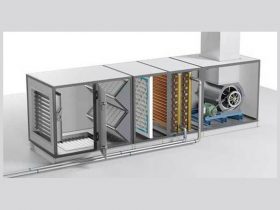Air Handling Systems
Introduction of HVAC
HVAC usually refers to the mechanical system of the building that provides heating, ventilation, and cooling within a building or a premise. This includes air conditioners, blower assembly, and evaporative coil, a compressor and compressor coil, thermostats, ductwork, and filters which help to distribute the conditioned air within a building.
APPLICATIONS
- HVAC designing an execution as per cleanroom standards.
- Cleanroom Partition Panels.
- Industrial air conditioning.
- Laboratory ventilation & air conditioning system.
- AHU
- Ducting
- Grills & Dampers
- Instrumentation
- Validation
Air Handling System
Thermocoat Double Skin Air Handling Units are one of the most versatile and premium products in HVAC. Air Handling Units play an important role in the overall performance of the HVAC system. In view of all theoretical and practical problems, Airtech has developed double skin units suitable for multiple applications. A self-supporting extruded aluminum framework with injected PUF insulated panels provides strength and rigidity.
Airtech AHUs range from 500 CFM to 50000 CFM. The base unit consists of a fan section, coil section, filter section, and mixing box.
Pre Fabricated Ducts
Available with us, is a quality proven range of air circulation systems that is used for rapidly ventilating an enclosed area with fresh external air. Offered in standard and dual-mode operations, these air circulation systems are offered to our clients in standard and customized specifications.
The Mode of operation of the dual circulation systems in mentioned below:
- Multiple barriers operate to create two airflow pathways.
- Two return air duct apertures are opened to expose the return air duct to an external air supply area via a fresh air duct.
- The fresh air duct includes an opening to the external air supply area.
- Two extensions are coupled to the return air duct apertures.
- Simultaneous operation of barriers to block the return air duct between the two return air duct apertures.
- This helps in the formation of two distinct return air duct segments
the central air unit and exit fan cooperate with the barriers. - This establishes two airflow pathways through the return air duct segments.
- First one is for extending the airflow pathway from the external sir supply area to the fresh air duct through the first, return air duct segment directly into the enclosed area before removal by the exit fan.
- The second airflow pathway extends from the external air supply area to the fresh air duct through the second return air duct segment through the central air unit through a supply duct into the enclosed area before removal by the exit fan.



